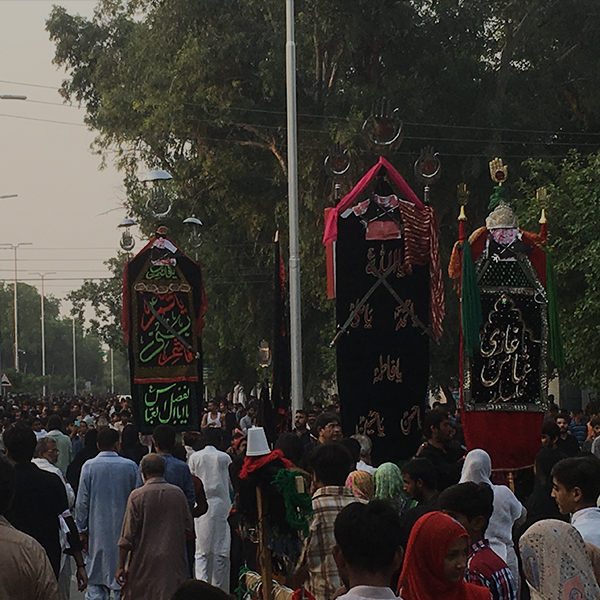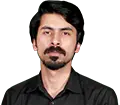Thousands of people gathered in Karachi on 10th of Muharram this year to participate in an annual procession. As they stopped near Preedy Street, in Saddar area, at around 1:15 pm to offer the afternoon prayer, an old-timer with a bent back and black clothes emerged from the crowd to lead the recital of a customary prayer which was telecast live on many news channels. As soon as he completed the prayer, the procession moved on.
Later that night, at around 9:30 pm, a sub-inspector of a police station in Karachi lodged a case against the old man, along with various other participants of the procession, under section 295-A of the Pakistan Penal Code (PPC) for deliberately outraging and insulting religious feelings. On the same day, Pakistan Electronic Media Regulatory Authority (PEMRA) suspended Channel 24’s license for its live transmission of the prayer. Three days later, on 2nd September 2020, some individuals lodged a case under Section 298-A of PPC (which covers words that wound someone’s religious feelings) and the Anti-Terrorism Act 1997 against Mohsin Naqvi, the chief executive of Channel 24. The complainants in these cases alleged the prayer contained insulting remarks against religious personages whom the majority of Muslims in Pakistan hold in high esteem.
Around six years earlier, one Syed Tufail Hyder travelled from Jhang, his hometown, to Gujrat to attend a Shia gathering but he got involved in a scuffle on 4th November 2014 and was arrested by Gujrat police for hurting two people. Two days later, Faraz Naveed, an assistant sub-inspector (ASI), struck his neck with an axe several times within the police station, killing him on the spot.
Faraz Naveed later claimed that he had killed Tufail Hyder because, during investigation, he had uttered derogatory remarks about some religious figures.
Qaiser Abbas was not even alleged to have committed blasphemy. One 6th September 2020, he was sitting at his shop in Kohat, sharing snacks with two friends when, suddenly, a man raced in and, in less than three seconds, sprayed six bullets into his body.
Qaiser Abbas breathed his last in another fifteen seconds.
The killing took place inside a busy market, suggesting that the killer was oblivious to the hustle and bustle around him -- as if he was on a religious duty, as if he was not committing a crime.
Minority report
Shias form around 20 percent of Pakistan’s population. Most of the time in the country’s history, they have remained at odds with other sects.
Muharram is traditionally the most happening time of the year for them as they arrange a range of commemorative events in this first month of the Islamic calendar. This Muharram, they held 36,000 majalis and 9,000 processions across Pakistan.
There, however, were corresponding incidents of reaction to these events as some rituals at them became grounds for sectarian confrontation. Consequently, more than 130 blasphemy cases were registered against Shias in various parts of Pakistan during that month.
These cases were mostly registered under sections 295-A, 298-A, and 153-A of the Pakistan Penal Code (PPC). The first two sections come under offences relating to religion. They, respectively, cover the “deliberate and malicious acts intended to outrage religious feelings of any class by insulting its religion or religious beliefs” and the “use of derogatory remarks in respect of holy personages”. The third section pertains to the promotion of enmity between different groups comes under offences related to public peace. In some instances, offenses covered under the Maintenance of Public Order Ordinance 1960 (MPO) and the Anti-Terrorism Act 1997 (ATA) were also added to the charges.
Muhammad Ahmad Ludhainvi, chief of an anti-Shia banned organization, Ahl-e-Sunnat Wal Jamaat (ASWJ), later boasted in a speech that 800 Shias were booked for committing blasphemy only in a matter of three recent months – including this year’s Muharram.
The registration of these cases began when a Shia orator, Asif Alvi, was accused of making derogatory remarks against religious personages in a speech at Layyah and was booked under section 298-A on 13th August 2020. He was booked in three more cases in the same month after he spoke at Khanewal, Islamabad and Gujranwala. He then fled to England.
De facto death sentence
The most worrying aspect of the ongoing wave of blasphemy accusations is that it undermines legal structures to the extent of making them hostage to vigilante actions and mob violence.
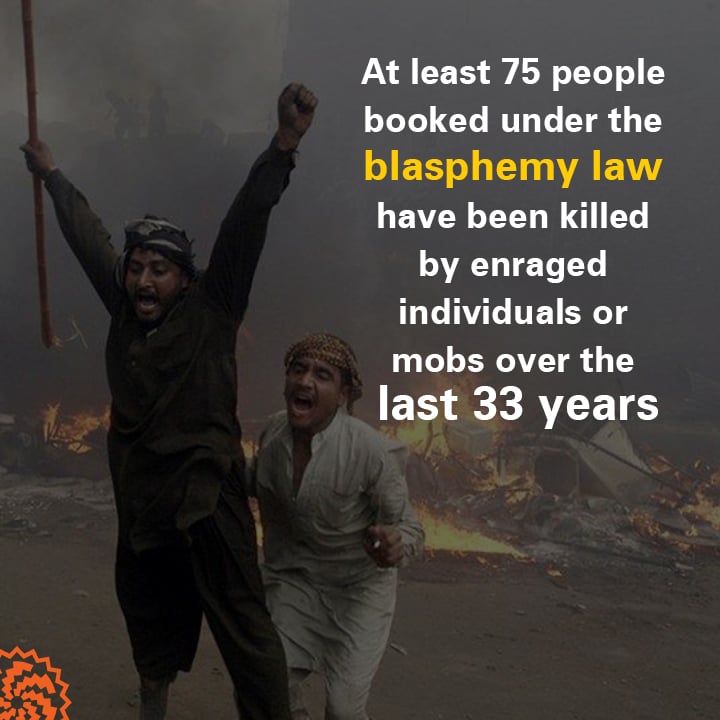
Here is what illustrates this: Section 295-C of PPC, a blasphemy law that mandates death penalty, was enacted in 1986; more than 1500 people have been charged under it since then but no one has been executed yet; but the Center for Social Justice, a non-governmental organization that works on human rights in Pakistan, points out that at least 75 people booked under this section have been killed by enraged individuals or mobs over the last 33 years. Some of those killed were even acquitted of blasphemy charges by courts.
Increasingly, other sections of the blasphemy laws are also becoming deadly.
For instance, there has been a steep rise in the number of cases registered this year under sections 295-A and 298-A. On average, around 99 such cases were registered in each of the five years between the start of 2015 and the end of 2019 but more than 150 of these were registered in just one month this year. This steep rise has coincided with increase in anti-Shia violence. At least seven Shias were gunned down -- and many others were attacked – this Muharram.
Violent attacks on 10th of Muharram processions were also reported from at least two places in Punjab -- Okara and Jauharabad. In both cases, mobs gathered at a central place on the traditional route of the procession. As soon as it arrived there, the mob started throwing stones at it, shouting ‘kafir kafir, Shia kafir! (Shias are infidels)’. In both cases, many participants of the processions were so badly injured that they had to be rushed to hospitals.
For Shias, who regularly participate in the annual Muharram events, such attacks would not ring too many alarm bells. In places like Jhang, a stronghold of organizations like Sipah-e-Sahaba Pakistan (the Army of the Companions), the largest anti-Shia group in the country, the absence of violence in Muharram is more surprising for local residents than its presence.
It is also not the first time that Shia beliefs, that many other sects consider blasphemous, have been expressed openly -- and also opposed in public. What, however, seems to be new is the increased use of religious laws to settle sectarian scores.
The cases filed against Shias are not just based on spontaneous accusations from offended citizens. Numerous extremist religious outfits, including the banned ones, such as Sipah-e-Sahaba Pakistan, have used these cases to come out on the streets. These outfits have tried to shift the focus from individual Shias being booked under blasphemy laws to framing a general narrative: that Shia faith, in general, is offensive towards important religious figures.
They have also started to proclaim -- like various other fascist organizations have done in other times and at other places -- that Pakistan’s Sunni majority is being endangered by a Shia minority. What follows is a hate campaign in which heads of anti-Shia organizations threaten that they will be forced to take matters ‘in their own hands’ if the state does not pay heed to their demand for taking action against blasphemy being allegedly committed by Shias.
The renewal of sectarian mobilization
With the rise of blasphemy cases against Shias, the digital space has been quickly taken up by a number of videos which show a member of Shia community being made to publicly denounce his faith. These pop-up courts remind one of similar spectacles from India in which Muslims are forced to chant Jai Shri Ram. The other important feature of these videos is that often they are recorded in the presence of law enforcement personnel.
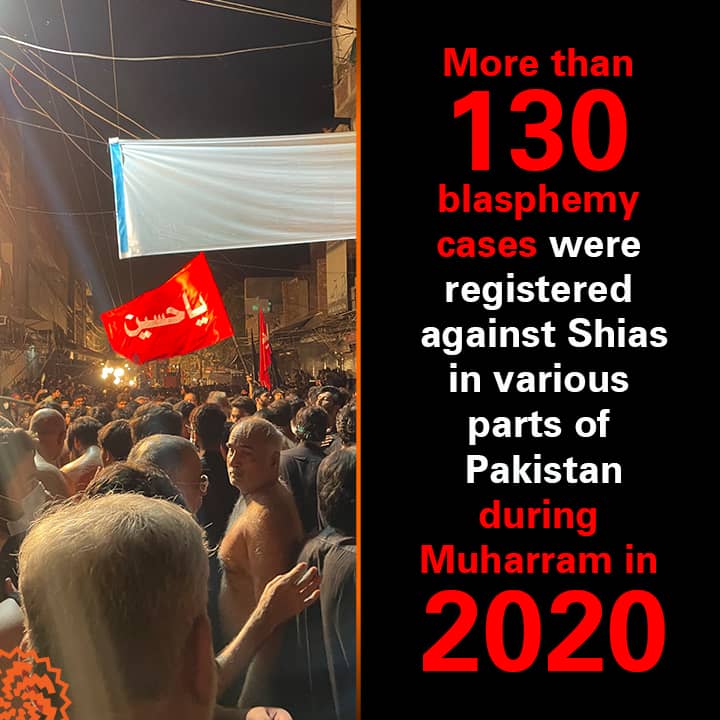
In the last couple of months, a series of anti-Shia processions have also been organized in different parts of the country. On 11th September 2020, thousands of people marched in Karachi, many of them holding the flags of Sipah-e-Sahaba Pakistan. They chanted anti-Shia slogans and also pelted stones at a Shia mosque. Over the next three days, similar gatherings were arranged by various strands of Sunni Islam, including Barelvis, Deobandis and Wahabis, in other cities.
The one organized in Islamabad on 17th September by Mutahhida Sunni Council, an amalgam of various religious organizations, was particularly virulent. It demanded legislation for giving death penalty to those who use derogatory words for the founders of Umayyad dynasty – the first hereditary Muslim monarchy that succeeded the first four caliphs. Addressing the gathering, a leader of the banned Ahl-e-Sunnat Wal Jamaat also called for a complete social boycott of Shias. He demanded the government pass legislation to deal with Shias “in the manner in which Qadianis were dealt with” and said that Shias who speak ill of religious figures should have their tongues cut off.
What turns these rhetorical threats into a palpable danger is the state’s tendency to capitulate in the face of popular mobilization. In Zaheeruddin versus The State in 1993, for instance, the Supreme Court of Pakistan legitimized violence against Ahmedis when it asked: “Can anyone blame a Muslim if he loses control of himself on hearing, reading or seeing such blasphemous material?” The court went to the extent of proclaiming that permitting an Ahmedi to display his religious identity “is like creating a [Salman] Rushdie out of him”. It then added another ominous question: “Can the administration, in that case, guarantee (Ahmadi’s) life, liberty and property and if so at what cost?”
The same question can be posed again in the current sectarian scenario: would anyone blame a Sunni if he loses control of himself on hearing, reading or seeing anything expressed by a Shia that could be deemed blasphemous?
Ali Usman Qasmi, a teacher at the Lahore University of Management Sciences (LUMS), says these changing patterns can be traced back to the beginning of the digital revolution of 2000s. “The ideological and historical fault-lines that polarized Shia and Sunni narratives had earlier remained limited to contests between religious scholars and, for the most part, the masses had to depend on these specialists for religious information,” he says. The state, according to him, only had to control these scholars to ensure a control over the masses. This control was exercised by house-arresting or banning the speech and movement of those who were most likely to foment sectarian strife.
After the digital revolution and the almost universal access to social media it has facilitated, Ali Usman Qasmi says, books and chronicles that contain polarizing narratives have reached the masses without any intermediation. “It now depends upon them how they use these texts,” he says.
Consequently, hundreds of self-proclaimed intellectuals and scholars have made their digital channels and it has become impossible to corroborate and counter any of the claims they make. Amidst this web of ‘Islamic knowledge’, issuing fatwas has literally become a cottage industry which only reinforces the historical fault lines.
The Barelvi renaissance
Traditionally, Shias were placed within Pakistan’s sectarian spectrum somewhat close to Barelvis. Among many anti-Shia terrorist organizations formed in the 1980s onwards, we do not see one that is centred on a Barelvi understanding of Islam. What, then, made Barelvis join the growing cacophony of name-calling towards Shias?
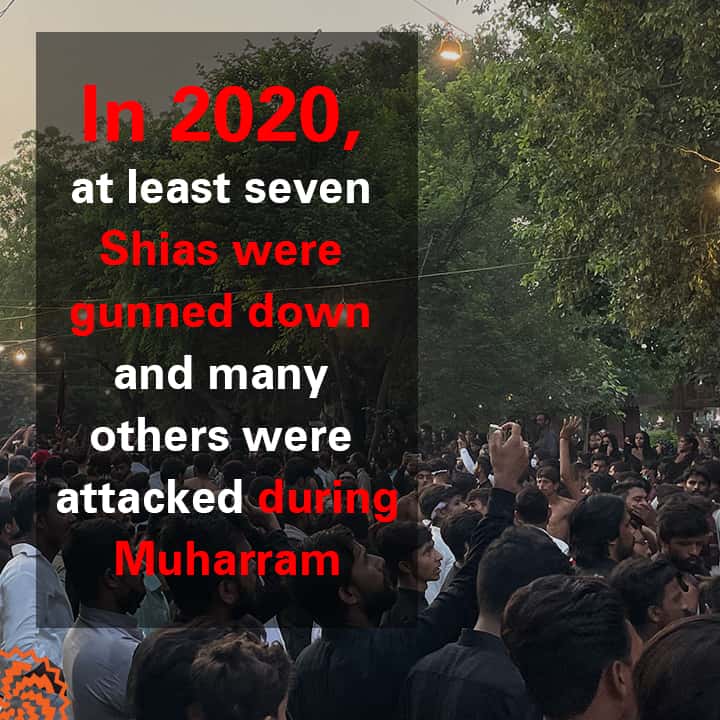
Some of it has its origin in a June 2020 sermon by Ashraf Jalali, a Barelvi cleric and a leader of Tehreek-e-Labbaik Pakistan (TLP), a religious-political party. He said things that outraged not just Shias but many members of Barelvi community outside TLP. Demands emerged immediately for him to be tried for blasphemy. Some Shia clerics also demanded that he be given death sentence.
The Jalali episode marked the culmination of a transition in Barelvi politics that had started after the 1990s. Barelvis claim they form the majority of Pakistan’s populace but are underrepresented in the institutions of the state -- such as civil service and education etc – which are dominated by Deobandis and Wahabis. What we see now, as Ali Usman Qasmi explains, is an assertive Barelvi politics which has always imagined itself at the center of Sunni dominance in Pakistan but has never been able to turn its numbers into a political and/or electoral eminence.
Since religious issues like respect for religious figures are ingrained in Pakistan’s social anatomy, Barelvis seem to believe it is only a matter of who gets to spearhead the movement to uphold the dignity of these personalities and thereby win over the masses. They exhibited this ability quite effectively in their 2017 shut-down and sit-in protests over a change in electoral laws that they thought were made to benefit Ahmedis.
The optics of recent anti-Shia gatherings, in which Barelvis tried to take a lead role, were also loud and clear: we can mobilize large crowds over the issue of disrespect shown towards religious personages.
The neo-sectarianism
Section 295-C of PPC, the blasphemy law that mandates death penalty for the use of derogatory remarks against the Prophet of Islam, was added to the penal code in 1986. Interestingly, Section 298-A, that criminalizes insult to important personages related to the Holy Prophet, biologically or otherwise, was passed six years earlier. Why was disrespect towards the Companions of the Holy Prophet made a crime more than half a decade earlier than the promulgation of 295-C?
Here is an explanation.
Section 298-A was added to the penal code in 1980 just months after a Shia revolution had taken place in the neighboring Iran and its sectarian shadow had begun to be cast over Pakistan. In the same year, General Ziaul Haq who was then ruling Pakistan, had passed the Zakat and Ushar Ordinances which Shias alleged to be a sectarian move since they do not believe in the state’s right to levy and collect religious taxes such as Zakat and Ushar. On 4-5th July 1980, Shia protesters besieged the federal secretariat in Islamabad and paralyzed the bureaucracy so effectively that the government had to give in and declare them exempted from these two taxes. This successful protest also became instrumental in the formation of a Shia political party, Tehreek-e-Nifaaz-e-Fiqh-e-Jafariya (TNFJ), which later became the arch nemesis of Deobandi groups like Sipah-e-Sahaba Pakistan and these rivalries caused unprecedented violence over the next two decades.
The fact that a minority forced the most powerful man in the country to take a U-turn was one of Zia’s major embarrassments so he sought to regain control by appeasing Sunni clergy through other means. From August to September 1980, he addressed a succession of government-organized conferences where ulema put forth proposals on how to Islamize the country. After the very first conference where ulema demanded laws to protect the dignity of important figures of Islamic history, the Zia regime added section 298-A to the penal code.
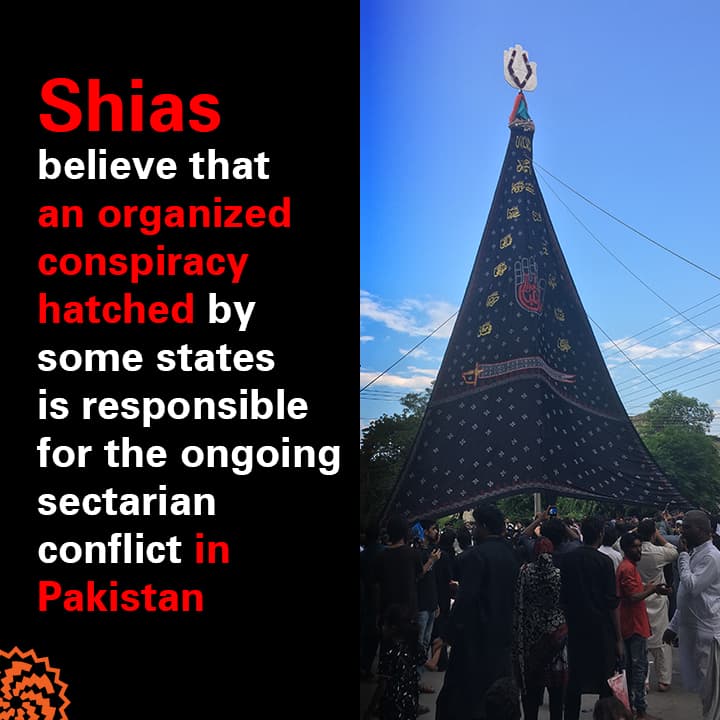
In the next six years, more clauses -- that criminalized the defiling of Holy Quran, disallowed Ahmedis from referring to themselves as Muslims, etc -- were also made a part of the law. This process culminated with 295-C being included in the penal code in 1986.
Out of these, Section 298-A is directly at odds with Shia faith whose very existence is premised upon what its adherents see as injustices by some important personages of early Islam. If a fundamental aspect of a community’s faith is deemed to be blasphemous by a country’s legal code, that puts that whole community in a state of ‘perpetual blasphemy’.
Asad Jamal, a lawyer and human rights advocate based in Lahore, concurs. According to him, the context in which Section 298-A was added to the penal code suggests that it was meant to undermine Shia community. “The manner in which this clause was added to the penal code further suggests that there is more to this clause than what meets the eye on the statute books.”
Intention matters or does it?
In May 1927, the Lahore High Court acquitted a Lahore-based Hindu publisher Rajpal on appeal after he was convicted by a trial court for publishing an offensive text against the Holy Prophet of Islam. The text was written by the members of Arya Samaj, an extremist Hindu organization. Two years after his acquittal, Rajpal was killed by a Lahori young man, Ilm-ud-Din.
The high court ruled in Rajpal case that he could not be tried since Section 298 (that covers words uttered with deliberate intent to wound religious feelings) only applied to speech and did not cover written texts and Section 153-A (which prohibits the promotion of enmity between different groups) did not apply with respect to deceased individuals including all notable Islamic personages. The court, therefore, directed the government to introduce new legislation to overcome this legal lacuna.
Resultantly, the colonial authorities added section 295-A to the penal code which criminalized “deliberate and malicious acts intended to outrage religious feelings of any class by insulting its religion or religious beliefs”. The British government of India, however, was very clear that insults to religion had to be deliberate in order to become the basis for a criminal case. Furthermore, such cases could be lodged only by the government and not by any individual.
When a draft of the law was presented before the Legislative Assembly in Delhi, Muhammad Ali Jinnah was not entirely happy with it. While he welcomed attempts at punishing those who incited hate and attacked revered religious figures, he also warned: “we must also secure this very important and fundamental principle that those who are engaged in the ascertainment of truth and those who are engaged in bona fide and honest criticism of a religion shall be protected.”
As noted by London-based scholar Asad Ali Ahmed in his analysis of Pakistan’s blasphemy laws published in Herald magazine in 2018, T A K Sherwani, a Muslim member of the Legislative Assembly, also said something that sounds like a prophecy come true: “He acknowledged that the law had been necessitated due to communal strife between Hindus and Muslims but raised the possibility that it might contribute to discord within the Muslim community, among Shias, Sunnis and Ahmedis.”
When General Ziaul Haq added new religion-centered clauses to PPC, he constructed his additions in a way that they altered the tone of the law altogether. Under the new clauses, barring 295-B, the elements of intentionality and willful action are no more considered as fundamental pre-requisites for determining guilt. Any derogatory expression about religious figures is to be considered a blasphemy irrespective of whether it is uttered as a deliberate act or not. While the Federal Shariat Court noted in 1990 that blasphemy under section 295-C has to be an “intentional or reckless wrong”, and ruled that it required mens rea or “intention, purpose, design, or at least foresight,” no such explanation was made for other clauses of religious laws.
This has had serious implications for the manner in which a blasphemy trial takes place. A lawyer in Lahore, who has appeared in courts in multiple blasphemy cases, says a blasphemy trial differs from other trials because no discussion or cross examination is freely carried out in it to determine whether the alleged derogatory expression is actually blasphemous or not. What complicates the situation further, he says, is the fact that the laws are so vague that they do not clearly define what ‘blasphemous’ or ‘derogatory’ actually means.
Judges, usually worried for their own safety, do not let lawyers dissect the words of someone accused of blasphemy. The prosecution only has to prove that the accused said or wrote the words that their accusers regard as blasphemous. If that is proven, the court does not bother whether those words were actually blasphemous or whether they were uttered deliberately to outrage religious feelings. The witness or a complainant, therefore, becomes the sole adjudicator of the crime.
Since the law is not clear on what comprises derogation or blasphemy, in multiple cases people have been accused of blasphemy in an utterly senseless manner. In May 2014, for instance, lawyers belonging to Jhang District Bar Association went on a strike after the police did not register a case against police officers accused of keeping a lawyer in detention. On the third day of the protest, after a scuffle between lawyers and police, the former raised slogans against a local policeman named Umar Daraz. On 13th May 2014, a blasphemy case under Section 295-A was registered against more than 60 lawyers because the mention of Umar in their slogans had allegedly outraged the religious feelings of policemen.
On 12th December 2010, a doctor belonging to Ismaili Shia community in Karachi was arrested and booked under the blasphemy laws after a complainant named Muhammad Faizan alleged that the doctor threw his business card into the dustbin despite the fact that it had Muhammad written on it. More recently, on 14th September 2020, a case was registered in Mananwala, a town in Sheikhupura district, under Sections 295-A and 298-A, against an individual for writing derogatory texts about Ilyas Qadri, Muneeb-ur-Rehman and Mahammad Ahmad Ludhianvi – the leaders of various Sunni groups.
Since the power to ascertain one’s guilt has been placed outside a court of law, this has led to an increase in fabricated blasphemy cases often made out of personal disputes. The Supreme Court pointed to this phenomenon in its decision on Mumtaz Qadri’s appeal against death penalty awarded to him for assassinating Governor of Punjab Salmaan Taseer. The court stated: “majority of blasphemy cases are based on false accusations stemming from property issues or other personal or family vendettas rather than genuine instances of blasphemy and they inevitably lead to mob violence against the entire community.”
Without delay, religious leaders met in Lahore on 8th May 2000 and made plans to agitate around the country. Another gathering was held in Karachi on 12th May where the attendees threatened the government with a nation-wide strike.
Only four days after that gathering, Musharraf announced that he was abolishing the mechanism. “I have decided to do away with the procedural change in registration of FIR under the blasphemy law … No one can even think of changing [Section 295-C),” he said.
Also Read
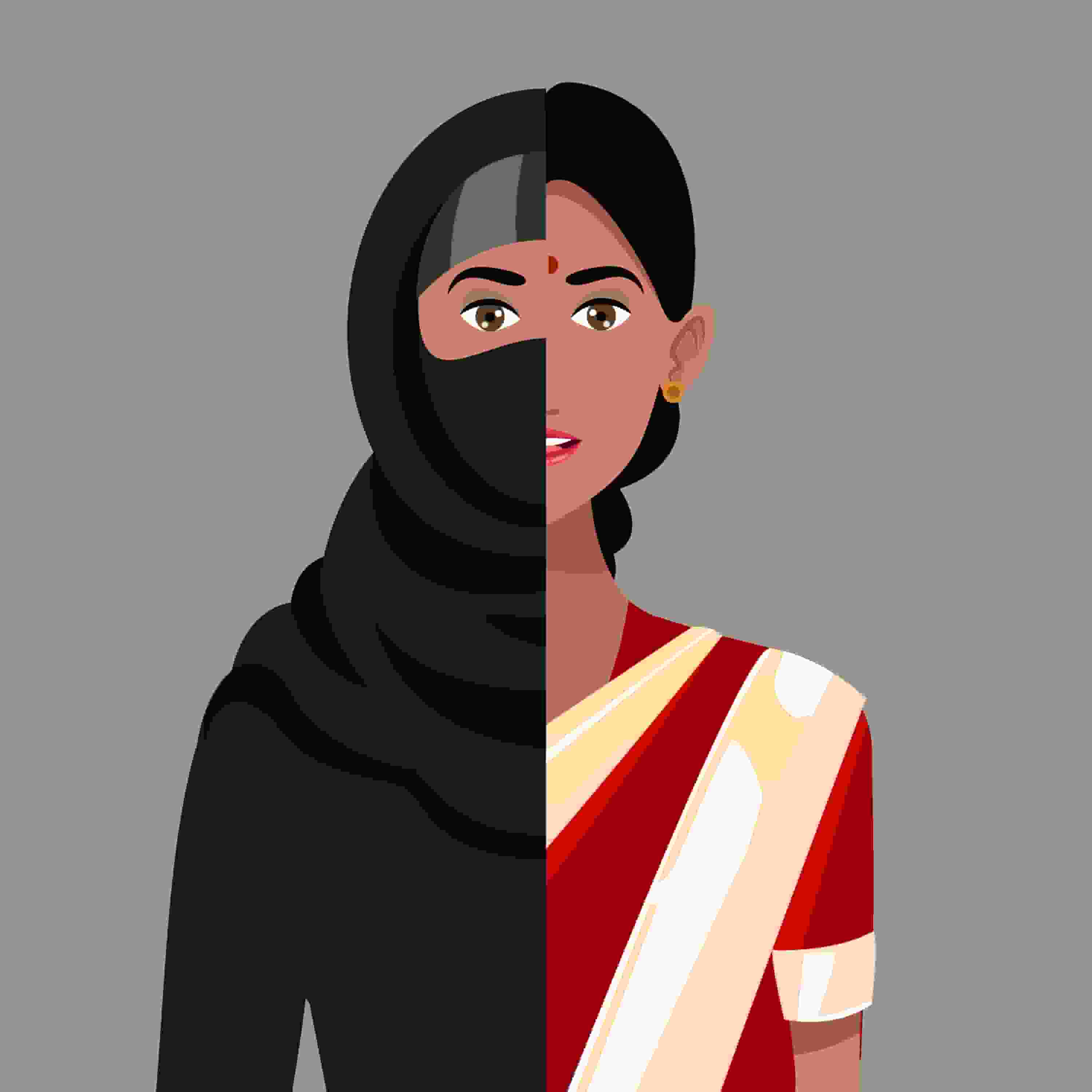
'Save our souls': Parents of forcibly converted Christian girls seek their rescue and rehabilitation
After this failed attempt, there remains no procedural oversight or safeguard to determine the veracity of blasphemy allegations before an FIR is registered. The fact that the law is vague about what constitute blasphemy -- coupled with the absence of procedural safeguards in the registration of cases -- means that allegations of blasphemy now often take the shape of mob violence.
Parliamentarian Sherry Rehman’s case illustrates this clearly. In November 2010, she submitted a private bill at the parliament, proposing, among other things, that a false accuser be given punishment under the same section of the blasphemy laws which he uses for lodging a case. Resultantly, she started receiving death threats and religious outfits threatened to protest against her bill. In 2011, under enormous pressure, she had to withdraw it from the parliament.
For Ali Usman Qasmi, the state’s complicity in weaponizing blasphemy has been quite evident since the 1980s but he believes that the current wave of blasphemy cases is more complex than just being state-sponsored. He explains how the post-9/11 decision of the state to go against religious faction that it had earlier supported has been met with violent backlash which may mean that the current set of state authorities does not intend to become a party to the sectarian conflicts. But, according to him, the state has become so partial and partisan over the last few decades that it is unable to intervene effectively in these conflicts for their resolution. “It is the state’s own Frankenstein that has reemerged,” he says.
Ali Usman Qasmi also suggests that anti-Shia conferences and rallies carried out recently were too big and too well organized that they could not have been possible without some direct or indirect assistance from the state. Similar fears have been expressed by a few Shia factions as well.
Speaking at a Shia gathering in Islamabad on 13th September 2020, Mohsin Ali Najafi, a noted Shia scholar, referred to Asif Alvi’s speech that marked the beginning of the blasphemy cases in recent weeks and said: “We had banned him from speaking. It was you who allowed him to. We have proofs that you especially organized a majlis, spent hundreds of thousands of rupees, had him make such a speech, and then had him go abroad immediately.”
It remains unclear who he was referring to as ‘you’ but some Shia community leaders allege that it was a government official who had invited Asif Alvi to speak in Islamabad.
Rashid Rizvi, a Shia activist based in Karachi, says something similar. He sees the ongoing sectarian conflict as being based on an organized conspiracy and states: “Banned terrorist organizations have been allowed to work and create sectarian ruptures.”
There are some other signs of the state’s perceived complicity as well.
Two months ago, the Punjab Tahaffuz-e-Bunyaad-e-Islam Bill was presented and passed in the Punjab Assembly almost unanimously. The bill puts serious restrictions on how and what could be published in the province and, among other things, also specifies how important Islamic figures should be referred to in published texts.
Many Shia clerics have come forward to reject the bill, calling it a tool to undermine their constitutional right to profess their faith freely. They also see it as an attack on their belief since it outlaws the prefixes and suffixes they generally use to refer to religious personages revered by Shias.
The bill has been stalled by Governor of Punjab Chaidhry Muhammad Sarwar without whose signature it cannot be added to law books. He says he will sign it only after a consensus is established among all the sects over its contents.
This report was first published by Lok Sujag on 16 Oct 2020, on its old website.
Published on 4 Jun 2022
